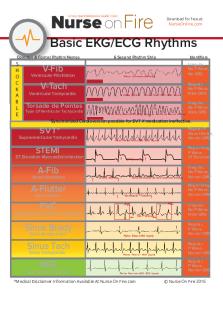Physiology ecg heart notes copy PDF

| Title | Physiology ecg heart notes copy |
|---|---|
| Course | Anatomy and Physiology |
| Institution | Cardiff Metropolitan University |
| Pages | 2 |
| File Size | 166.9 KB |
| File Type | |
| Total Downloads | 92 |
| Total Views | 124 |
Summary
Physiology ecg heart notes copy...
Description
Physiology Heart review - 4 chamber muscular pump - Thoracic cavity Electricity of the heart- contractions of any muscle is associated with electrical changes. These changes can be detected by an electrode attached to the surface of the body. All muscular contractions can be detected therefore skeletal muscle bust be still. cardiac cycle – look into more Systolic phase-= ventricle contraction Pace maker – SA node (RA) AV junction – AV node + bundle of hiss LBB+RBB Purjinke fibres A typical ECG wave is; - P-wave - QRS complex – electrical impulse moving through the ventricles (ventricular depolarisation) - T-wave – ventricular re-polarisation (about to start relaxation) How to conduct the test?
Use of 10 electrodes Focused around the ventricles. Specific locations. RR- right arm LA- left arm RL- right leg LL- left leg
V1- right sternal border, 4th intercostal space V2- left sternal border, 4th intercostal space V3- in a diagonal line between v2+v4 V4- 5th intercostal space, mid clavicular line V5- mid axillary line, 5th intercostal space V6- anterior axillary plane, 5th intercostal space
Lead 1 – RA(-) to LA (+) Lead 2 – RA(-) to LL(+) Lead 3 – LA(-) to LL(+) aVF aVL aVR
1 small square = 0.04s 1 large square = 0.2s 5 large squares = 1s 300 large squares = 1 min
300 divided by number of large boxes between R waves “RR interval” = HR...
Similar Free PDFs

Physiology ecg heart notes copy
- 2 Pages

heart anatomy and physiology
- 4 Pages

ECG - ECG notes
- 3 Pages

Basic ECG - ECG
- 14 Pages

Heart disease lecture notes
- 6 Pages

ECG 1 - Atividades ECG- cardiologia
- 12 Pages

ECG 2020 - ECG - LE TOURNEAU
- 7 Pages

Informe ECG
- 22 Pages

ECG - electrocardiograma
- 5 Pages

ECG pléthysmographie
- 2 Pages
Popular Institutions
- Tinajero National High School - Annex
- Politeknik Caltex Riau
- Yokohama City University
- SGT University
- University of Al-Qadisiyah
- Divine Word College of Vigan
- Techniek College Rotterdam
- Universidade de Santiago
- Universiti Teknologi MARA Cawangan Johor Kampus Pasir Gudang
- Poltekkes Kemenkes Yogyakarta
- Baguio City National High School
- Colegio san marcos
- preparatoria uno
- Centro de Bachillerato Tecnológico Industrial y de Servicios No. 107
- Dalian Maritime University
- Quang Trung Secondary School
- Colegio Tecnológico en Informática
- Corporación Regional de Educación Superior
- Grupo CEDVA
- Dar Al Uloom University
- Centro de Estudios Preuniversitarios de la Universidad Nacional de Ingeniería
- 上智大学
- Aakash International School, Nuna Majara
- San Felipe Neri Catholic School
- Kang Chiao International School - New Taipei City
- Misamis Occidental National High School
- Institución Educativa Escuela Normal Juan Ladrilleros
- Kolehiyo ng Pantukan
- Batanes State College
- Instituto Continental
- Sekolah Menengah Kejuruan Kesehatan Kaltara (Tarakan)
- Colegio de La Inmaculada Concepcion - Cebu





